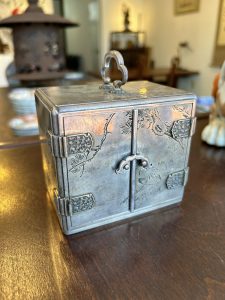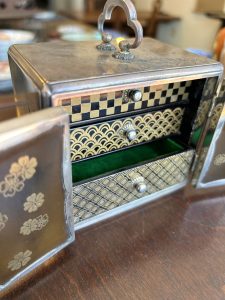幸せを願う銀製の宝石小箱(愛知県名古屋市千種区姫池通 骨董買取 古美術風光舎)
2023.09.24
皆さまこんにちは。スタッフHでございます。
今朝、電車の中は夏真っただ中の服装の方から、すっかり秋の装いの方まで様々でした。本当に何を着るか迷う今日この頃です。
さて、店内でずっと気になっていたこの小さな銀製の宝石箱。中が小さな箪笥のようになっています。金工品と呼ばれるそうで、金・銀・銅・鉄・錫などの金属を加工してできる工芸品の総称です。こちらは昭和初期のものですが、日本では弥生時代に中国大陸・朝鮮半島から伝わった金工技術によって剣や銅鐸、装身具などが作られたのが始まりだとか。

こちらの宝石箱は手のひらにのるサイズの愛らしさです。外側には常緑樹で不老長寿の象徴とされる松が彫られ、正面と側面に一羽ずつ小鳥が装飾されています。おしどりでしょうか。金具にも細かく細工がされ、葉の形から「ナズナ」にも見えます。春の七草の一つで長寿や無病息災の縁起の良い植物です。ちなみに花言葉は海外と日本と共通で「あなたに私のすべてを捧げます(I offer you my all)」だそうです。ロマンティックなような少し重いような…。
扉を開けると3段の小引き出しにそれぞれ違った文様が装飾されています。1段目は市松模様、2段目は青海波、3段目は鹿の子でしょうか。お馴染みの和柄ですが、改めて調べてみました。

市松模様は2色の違う正方形を交互に並べて構成される文様で、連続する四角が途切れずに続くことから「子孫繁栄」や「事業の拡大」を意味します。日本だけでなく、世界中で古くから織柄として存在し、西欧ではチェス盤からチェックなどと呼ばれています。
日本の市松模様の歴史は古く、縄文時代後期に作られた「深鉢型土器」の表面には、約5㎝四方の市松模様が描かれています。また6世紀の古墳時代後期に作られた「貴人埴輪」(きじんはにわ)の袴にも市松模様が描かれています。このシンプルにも見える模様は、人間にとって何か本能的に永続性や無限の広がりを感じさせ、魅力を感じるものなのかもしれませんね。
江戸中期の歌舞伎役者であった佐野市松がこの文様の袴を愛用していたことをきっかけに「市松模様」と呼ばれるようになりました。
東京オリンピック・パラリンピックのエンブレムや流行りの漫画でも使用され、未だ人気は衰えませんね。
2段目は青海波。半円を三重に連続させて波を表現しています。発祥はペルシャとされていますが、名前の由来は雅楽の演目「青海波」とされています。終わりなく続いていく波模様には未来永劫穏やかに暮らしていけますようにとの願いが込められ、結婚のお祝いでよく使われます。
3段目の鹿の子文様は、小鹿の背中に見られる白い斑紋を表現しており、鹿の子文様の絞り染めは手間がかかるため高級品とされています。日本の歴史において鹿は神様からの使いだと考えられ、現在でも春日大社や鹿島神社のなどでは鹿を手厚く保護しています。鹿は繁殖力と生命力の強い動物で、子孫繁栄や長寿の意味もあり縁起の良い文様とされています。
扉の内側の桜も昔から「五穀豊穣」や「繁栄」の象徴とされており、この小さな宝石箱には幸せを願う気持ちが目いっぱいに詰め込まれています。そんな気持ちを持ち主だった方も感じていたことでしょう。そしてまた誰かに引き継がれていくとしたら素敵なことですね。

それでは、またお会いしましょう。
Hello everyone. This is Staff H.
This morning on the train, there were many people dressed in summer clothes and others in autumn attire. It is really hard to decide what to wear these days.
I have been wondering about this small silver jewelry box in the store. It looks like a small chest inside. It is called “metalwork,” which is a general term for crafts made by processing metals such as gold, silver, copper, iron, and tin. In Japan, swords, bronze bells, and ornaments were first made using metalworking techniques introduced from the Chinese continent and the Korean peninsula during the Yayoi period.
This jewelry box is a lovely size that fits in the palm of your hand. The outside is carved with a pine tree, an evergreen symbol of longevity, and the front and sides are decorated with small birds. A small bird is decorated on the front and side. The metal fittings are also finely crafted. It is one of the seven spring flowers and is a plant of good omen for longevity and good health. Incidentally, the language of flowers is the same in both Japan and overseas: “I offer you my all. It sounds romantic and a bit heavy…
When you open the door, you will find three small drawers, each decorated with a different pattern: the first drawer has a checkered pattern, the second has a blue sea wave, and the third has a “fawn” pattern, I guess. These are familiar Japanese patterns, but I looked them up again.
The checkered pattern is a pattern composed of alternating squares of two different colors, meaning “prosperity of descendants” or “expansion of business” because the continuous squares continue uninterrupted. The checkered pattern has existed as a woven pattern not only in Japan but around the world since ancient times, and in Western Europe it is called “check” after the chessboard.
The checkered pattern has a long history in Japan, with a checkered pattern of approximately 5 cm square being drawn on the surface of “deep bowl earthenware” made in the late Jomon Period. The checkered pattern is also found on the hakama of a “Kijin Haniwa” (noble clay figurine) made in the late Kofun period (6th century). This simple-looking pattern may instinctively evoke a sense of permanence and infinite expanse, and may be something that humans find attractive.
The name “checkered pattern” was coined after Sano Ichimatsu, a kabuki actor of the mid-Edo period, used this pattern on his favorite hakama.
It has been used in emblems for the Tokyo Olympics and Paralympics and in trendy cartoons, and its popularity has not diminished yet.
The second row is the aonami wave. It is made up of a series of three semicircles to represent waves. The origin of this design is said to be Persian, and the name is said to come from the Gagaku (ancient Japanese court music) performance “Seigaiha (blue ocean waves). The endless wave pattern is often used in wedding celebrations to express the wish for a long and peaceful life in the future.
The third row, the “fawn” pattern, represents the white spots seen on the back of a fawn. In Japanese history, deer were considered to be messengers from the gods, and even today, deer are heavily protected at shrines such as Kasuga Taisha and Kashima Shrine. The deer is an animal with strong fertility and vitality, and is considered an auspicious symbol for prosperity of offspring and longevity.
The cherry blossoms inside the door have also long been considered a symbol of “good harvest” and “prosperity,” and this little jewelry box is filled to the brim with wishes for happiness. The owner of the box must have felt these feelings. And it would be wonderful if it is passed on to someone else again.
Well then, let’s meet again.
*******************
ご実家の整理やお片付けなどをされている方のご相談などが多くございます。
お片付けなどくれぐれもご無理のないようになさってくださいませ。
風光舎では古美術品や骨董品の他にも絵画や宝石、趣味のお品など様々なジャンルのものを買受しております。
お片付けをされていて、こういうものでもいいのかしらと迷われているものでも、どうぞお気軽にご相談下さいませ。
また風光舎は、出張買取も強化しております。ご近所はもちろん、愛知県内、岐阜県、三重県その他の県へも出張いたします。
まずは、お電話お待ちしております。
愛知県名古屋市千種区姫池通
骨董 買取【古美術 風光舎 名古屋店】
TEL052(734)8444
10:00-17:00 OPEN
#出張買取#骨董#古美術#骨董品#絵画#版画#茶道具#刀剣#彫刻

